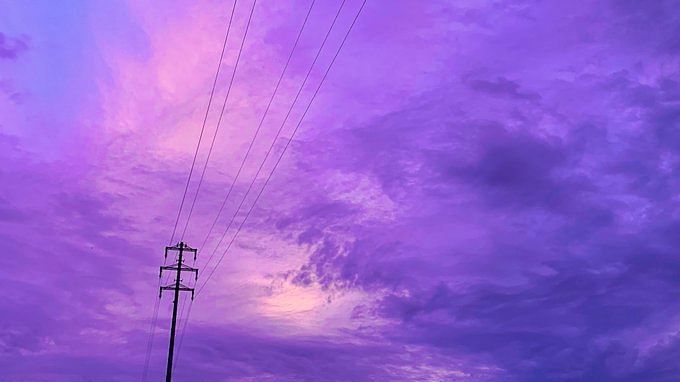Bengaluru: At least 10 people were killed and around 140 injured as Typhoon Hagibis made landfall in Japan at 7 pm Saturday (local time), with wind speeds of 144 kmph and heavy rains.
Hagibis, which means “speed” in the Filipino language of Tagalog, is reportedly the worst storm Japan has seen in 60 years. The same day, Japan was also struck by an earthquake, measuring 5.7 on the Richter scale, off its south-eastern shore.
As Hagibis wreaked havoc, social media was flooded with shocking images of the storm’s impact — trucks falling like dominoes, roofs flying off buildings, and flooded streets.
Hagibis raised the water level by a metre along several parts of the Japanese coast. Six million people have been affected by the typhoon, which is expected to head out to sea again by end of the day Sunday.
Purple sky
However, until just a day before, another flurry of images from Japan was causing immense curiosity on social media: A dark pink, almost purple sky.
駅からでたら、そこは魔界だった pic.twitter.com/x8blDBthOu
— しう坊 (@Desu_unknown) October 11, 2019
空の色がおかしい….
日本が終わる予兆か??? pic.twitter.com/GA5bYH4g74
— あらーと⚠️ (@ara_to1) October 11, 2019
https://twitter.com/PriyantharaEka/status/1182938771248971777?s=20
While some people sought to derive spiritual meaning from the colour, there’s a simpler explanation for the phenomenon, which is seen as the harbinger of storms.
I was searching for the meaning of purple sky just now. So, please pray for Japan because nothing is impossible and maybe fate can be turned out the opposite way. #PrayForJapan pic.twitter.com/J83V1t8dqk
— (っ◔◡◔)っ (@shoegotlaces) October 12, 2019
Even in animes, a purple sky is never a good sign. It means something scary is about to begin. #PrayForJapan ?❤️? pic.twitter.com/LpCONMZYG7
— Harshil Vastarpara (@imVHarshil) October 12, 2019
The colour of the sky can be attributed to refraction, but it isn’t as simple as that either.
When sunlight hits the atmosphere, gas molecules and dust tend to scatter all the different wavelengths of light. However, red, orange, yellow, green from the visible spectrum (VIBGYOR) can reach the surface largely uninterrupted because they have longer wavelengths and are scattered less. But shorter wavelengths like blue and violet get scattered everywhere, and thus don’t really reach our eyes.
An intense storm, especially a typhoon coming in from the ocean, tends to modify the composition of the atmosphere. Storms wash away the larger particles that typically absorb more light and scatter multiple wavelengths uniformly. This makes the colours of the sky appear more vivid.
During a typhoon — also called a cyclone or hurricane in other parts of the world — warm air rapidly rises over the sea and causes evaporation, which leaves higher amounts of salt molecules in the atmosphere. These, in turn, cause a more widespread scattering of shorter wavelengths, enabling us to see them.
The sky turned purple today in Osaka. #TyphoonHagibis #myfirsttyphoon pic.twitter.com/H1tFFDXade
— Aled Rhys Evans (@AledDreamState) October 11, 2019
But there’s more.
Often, what we see aren’t really purple skies, but pink skies superimposed on the blue behind.
https://twitter.com/ika_mesugorira/status/1182656293477244929
At sunrise or sunset during a storm, there can be greater scattering of longer wavelengths because of increased humidity, causing pinkness. When superimposed against a dark blue sky, the colours can mix and we see the sky as purple.
These pictures became viral on Twitter as it shows an unusual appearance of the sky.
What's behind these pink clouds?
The color is not totally "pink", but a "pinkish red" or "purplish red". We can sometimes see it, specifically during sunrise/sunset.#Hagibis #TyphoonHagibis pic.twitter.com/wRssRZXMJy
— Matthew S. Cuyugan (@MatthewSCuyugan) October 11, 2019
Also read: Frequent thunderstorms and dust storms another gift of a warming world




Typhoon Hagibis played havoc in Japan with huge damage through rain and winds in Tokyo as well on 12 and around in October 2019. Nearly a million residents were asked to vacate and move to safer locations while over five dozens are said to have died. The typhoon Hagibis is said to be worst in 60 years , following a storm that rattled Japan a month past in September , 2019. In this context , it is apt to refer readers to this Vedic astrology writer’s predictive alert in article – “ Fresh look and innovation at strategies becoming focus for Japan in coming year 2019 , a Vedic astrology view” – brought to public domain widely last year 2018 in October-November. In relation to September –October 2019 , the text of the alert in the said article , reads like this :-
“ More care may be paid during these months while dealing with or storing or handling fire , chemicals , explosive , nuclear-energy , hydro-power and the like. Some health hazards or health concerns………….. could manifest during the year , more so during the aforesaid months. One or more of such regions as Kitakyushu , Yonago , Kyotco , Yokohama or other vulnerable regions in Japan may keep a note for taking more care and appropriate strategy. ………..Hurricane or storm could also cause worrisome concerns in one or more regions of Japan mentioned in this article before”. It seems that predictive alerts of this writer may have been found to be meaningful.
“But shorter wavelengths like blue and violet get scattered everywhere, and thus don’t really reach our eyes. ”
“These, in turn, cause a more widespread scattering of shorter wavelengths, enabling us to see them.”
?
Great article Sandhya… keep them coming!